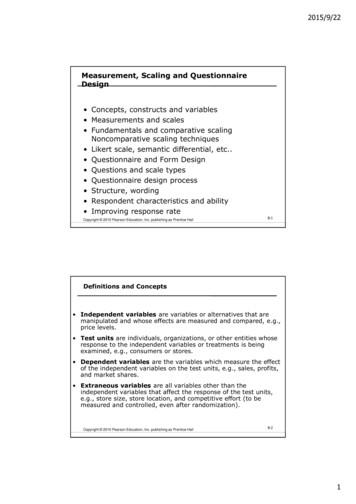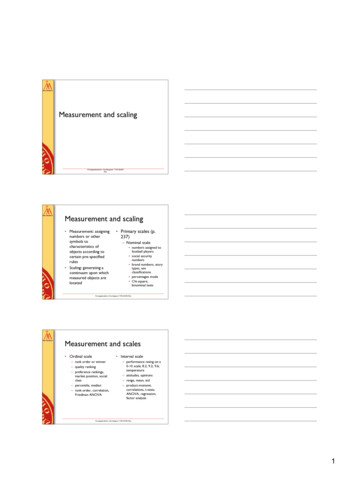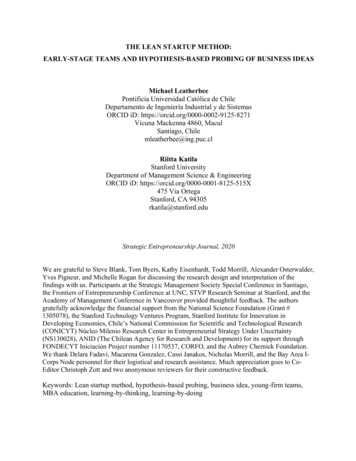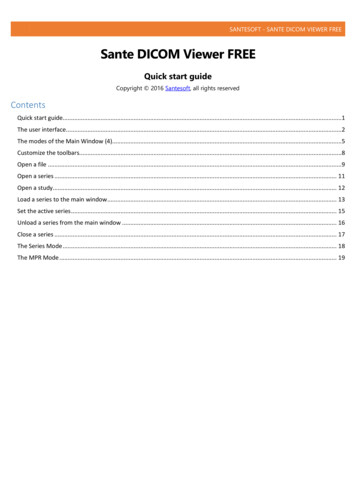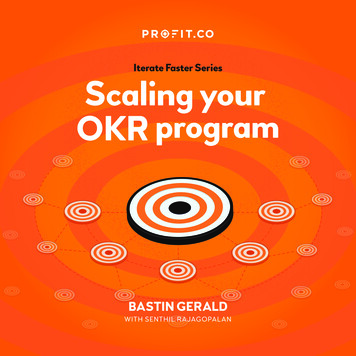
Transcription
Iterate Faster SeriesScaling yourOKR programBASTIN GERALDWITH SENTHIL RAJAGOPALAN
Scaling yourOKR programBASTIN GERALDWITH SENTHIL RAJAGOPALAN
Copyright Year: 2021Copyright Notice: by Bastin Gerald. All rights reserved.The above information forms this copyright notice: 2021 by Bastin Gerald.All rights reserved.9 781794812031
Table ofContents01What should your OKRquarter look like?106Why do you seeUnbalanced Progress inyour OKRs?4502How do you ensure thatyour OKRs are good, atscale?807What is OrganizationalLearning and why is itimportant?7303How do you prioritizeyour OKRs?2108The quarter is over.What next?8604 How do you automatedaily management?3409What red flags shouldyou be on the lookout forin your OKR program?9605 When do you automatecheck-ins?3910What are the signs thatyour OKR program hasmatured and is runningwell?115
IntroductionManagement is doing things right; leadershipis doing the right things.Peter DruckerOKRs implemented the right way can be highly rewarding for teams and businesses. They canincrease visibility for everyone, create an agile working environment, drive you to achievestretch goals, and help you build high performance teams. The first two books in this OKRProgram series, Planning for your OKR Program and Launching your OKR Program, covered thefoundational aspects of an OKR program. This book, Scaling your OKR Program, is the thirdand final book in this series.At this point, you have planned your OKR program well, launched OKRs for your first fewbusiness units, and have successfully completed the first quarter. Now, it’s time to scale up androll out to the rest of the organization; and this book can help.Here, you will learn the ways that you can schedule your quarter with OKRs, prioritize yourgoals, use OKRs to create a learning organization, maintain best practices throughout yourOKR program, and the signs and signals you must watch out for to determine if your OKR
program is headed off track, or on the path towards success.This book is filled with practical advice that you can put to work today. The OKR calendarsuggested in Chapter 1: What should your OKR quarter look like? is a great template for you tocreate your own customized OKR quarterly calendar for your organization. Chapter 3: How doyou prioritize your OKRs, provides a great framework to help you choose the right objectivesand Key Results. Chapter 7: What is Organizational Learning and Why is it Important?introduces the concept of learning organization and provides the guidelines for using yourOKR program to build a learning organization.The advice found in this book has helped hundreds of OKR implementations across the globe.Many have been spectacularly successful while some have missed the initial ambitious goals.We have synthesized the valuable lessons learned from these experiences into the last twochapters with treasured insights on the signs of a successful OKR implementation as well as thered flags. We wish you amazing success with your OKR program.
What should your OKR quarter look like?1What should your OKRquarter look like?An OKR quarter can be well-structured and consistent when you have a very mature OKRprogram.The phrase mature OKR program implies that if you’re in your first quarter using OKRs, youprobably will not see this strong structure. In fact, it may be two or three quarters beforeyour company’s culture and your team dynamics adjust to using OKRs as your main way todetermine business health and progress.What would this mature OKR structure look like? While nothing about the OKR frameworkis one size fits all, there are a handful of recommendations that can improve your experienceimplementing and managing OKRs.Scheduling your Quarter with OKRsYou can use these schedule suggestions (Figure 1.1) as a starting point and tweak them to yourpreferences.Your quarter using OKRs can look like this:1
What should your OKR quarter look like?Complete OKR planning for quarterMonth 1SUNMONTUEWED1238915Month 2425262728293031TUEMonth 2789131415161920212223262728293031All Mondays2nd Wed. of theMonth3rd Wed. of theMonthWeeklyreviewsat all levelsCelebration &recognitions(Team Level)Learnings,brown bagsessions,externalspeakersLast Wed. ofQuarterCompany &team town halls,broadercelebrations,learnings &recognitionsAll FridaysCheck-insreviews,comments, andclarifications.Reflect/ Reset for currentquarter; OKR planning fornext quarterFigure 1.1: A suggested starting point for how to bring the OKR framework into your quarterly schedule.This breakdown can be adjusted by OKR champions as their teams get used to the cadence of OKRs.To help you understand what you must include in your quarterly calendar for a successfulOKR calendar, let’s organize the key dates in this calendar around the PEEL cycle. The fourstages of the PEEL cycle are: Plan Execute Engage LearnPlanAll companies should kick off their quarter with a planning session. Taking an entire month2
What should your OKR quarter look like?to plan your quarter’s OKRs would be a disaster. Ideally, your plan for the quarter should be inplace by the end of your first week.Now, this could seem very idealistic and not practical, especially when you are at the beginningof your OKR journey. For some teams, it’s achievable, and for others it’s not. However, it’s agood goal to strive towards.It might take two, three, or four quarters for your team to plan their OKRs within a week. Themore planning cycles your team goes through, the easier it will be to identify the quarter’smost important priorities. This process will eventually feel business-as-usual, and your teamwill be able to set and align OKRs in the first week without issue.ExecuteThroughout the quarter, you should schedule weekly or biweekly check-ins. These willtypically take place on Fridays as a summary of your week as a whole. While you can set checkins at any cadence and on any day that suits your company’s needs, you must keep check-insconsistent. OKR champions and business leaders should stress the importance of updatingkey result progress, status, and writing comments every week.You can use the PPP framework or something similar to structure your reporting. The PPPframework asks users to record the progress, plans, and problems faced while working ontheir key result during the last check-in period. Structuring reviews around these threecomponents will help users hit on all of the important information associated with their keyresult and keep check-ins informative and to the point.EngageOnce check-ins are completed, they should be reviewed by managers and stakeholders tounderstand so everyone is up to date on the latest key result progress. Teams should also3
What should your OKR quarter look like?discuss the plan for each week and the roadblocks they are facing while making progress onkey results.Check-ins, commentaries, and reports can be reviewed on Mondays. When your organizationhas multiple levels in the business, you can split up your review meetings in groups. Askteam leaders to hold lower-level team meetings individually to discuss check-ins in-depthand work through important problems as a unit. Then, at the higher-level team meetings,ensure that everyone has a chance to update the entire group with a shorter summary ofwhat was accomplished and what plans and problems people have. This helps maintain fulltransparency throughout the business and keep the team aligned without glossing over anyimportant issues with brief big-picture meetings.On the calendar shown above (Fig. 1.1), these reviews happen each Monday. Like check-ins,this cadence can be adjusted to fit the exact needs of your team.1-on-1s between managers and their direct reports should focus on OKRs. When your teamhas their focus trained on OKRs, you can quickly learn what is working, what is not, and whatneeds to be done to help your team members accomplish their targets.OKR-focused meetings make conversations more meaningful. While you want your teammembers to get things done, there can be a lot of “points of failure” that need to be addressedalong the way. When you have check-ins cataloguing what has been tried and didn’t work, youcan provide meaningful guidance or appropriate help efficiently.Additionally, it’s wise to use your second Wednesdays of the month for celebrations andrecognitions. These celebrations can be localized at the team or department level.These meetings should have an agenda and have a standard process for recognizing greatwork.4
What should your OKR quarter look like?Once per quarter, you should hold a broader business unit or company-level town hall meeting.In this calendar, the standard day is Wednesday (Fig. 1.1). However, you can choose any daythat works for you. During these last Wednesdays, you can have a company-level State-of-theunion or a business-unit-level State-of-the-union.Have the appropriate C-suite executives share their updates as needed. You can certainly runthrough your company-level OKRs and where you stand while you are wrapping your quarteras well as share the company-level priorities for the next quarter.You can also have broader celebrations, broader learning, and recognition at the largedepartment, business unit, or company-level as appropriate. It’s tough to have a companylevel State-of-the-union every quarter if your company is large, but you have to work throughand figure out what is best for your organization’s culture, size, and OKR cadence.LearnLearning should be a big part of your company’s OKR culture. You can dedicate the thirdWednesday of the month to learning.Apart from your team members sharing their learnings in these sessions, you can supplementyour learning culture by: Gathering customer feedback about what worked well, what didn’t, and what could haveworked better Invite industry experts to speak to your team and share expertise related to what youare trying to accomplishWhether these learning sessions take place at the business unit level, department level, orteam level is entirely up to you to decide based on your company’s needs. However, it’simportant to have a day dedicated to learning and growing as a company. Learning is a vital5
What should your OKR quarter look like?component of success with the OKR framework.While learning should be a part of your weekly routine, you should also go through a longerreflection process at the very end of each quarter. This process collates the information andlearnings you’ve gathered each week and asks users to consider their OKR progress.Many businesses with mature OKR programs take a few weeks to complete the Reflect/Resetprocess at the end of the quarter. So, you won’t be alone if you take a few weeks to get thisdone appropriately. It’s important not to rush through this learning process, and you shouldaim to complete your reflect/reset process in one or two weeks.PlanExecuteEngageLearnCorporate OKRsDepartment OKRsAlignmentsCheck insWeekly team one on one feedbackDashboardsTasksAwardsHashtagged conversationsEnd of quarter reflectionsReset for next quarterFigure 1.2: This image demonstrates how the PEEL cycle fits into your OKR quarter,and how the “learning” stage of the process links directly to the “planning” stage.6
What should your OKR quarter look like?The learning stage of the PEEL cycle connects directly with the planning stage of your nextquarter. During the reflection process, where you record what you’ve learned throughout thequarter, you will also reset your OKRs or extend existing OKRs into the next quarter. OKRsfor the following quarter should always be well-informed by your past experience, linking the“learn” and “plan” phases of the PEEL cycle (Fig. 1.2).Final ThoughtsKeep in mind that the calendar shown in this chapter is simply a starting point for yourindividualized OKR program (Fig. 1.1). Your own quarterly OKR calendar will be influencedby your organizational culture, structure, and business processes. So, your calendar will reflectthe specifics of your organization in some way, shape, or form.Get started with the basics presented here, and modify and adapt as needed in yourorganization. For example, some companies might elect to set OKRs on an annual basisrather than a quarterly one, or check-in cadences will be bi-weekly rather than weekly. Everychoice your organization makes for its OKR program will make your quarter with OKRs lookdifferent— the most important thing is that the leadership team is dedicating time and effortto ingraining this strategy-execution framework into the DNA of your company.7
How do you ensure that your OKRs are good, at scale?2How do you ensure that yourOKRs are good, at scale?Objectives and Key Results (OKR) software, when correctly deployed, is a powerful tool thatcan be used to guide an organization towards success. However, the way that the OKR softwareindustry has evolved has caused many company leaders to approach the framework withmany preconceived re 2.1: An image depicting what it takes to achieve your goals using the OKRframework; you must focus on the right things, with the right people, who do things right.8
How do you ensure that your OKRs are good, at scale?These notions include the idea that OKRs are synonymous with task management orperformance management. Both of these perceptions can cause issues with a company’s OKRimplementation.One question that many individuals new to OKRs ask is: “Will OKRs improve the performanceof underperforming teams or underperforming employees?”Can OKRs boost the performance ofunderperforming teams and employees?It is a common question many people ask when testing waters with OKRs. It’s important tonote that the OKR framework isn’t a performance management methodology. However, OKRscan be used to help employees make better use of their time, effort, and skill. OKRs are a greatway to get the most out of your team and therefore improve performance— but the approachyou take to this performance improvement is very important.The Business Process EquationFrom a bird’s eye view, a business has several core business processes, as well as a set of toolsto create output. These outputs, in turn, lead to meaningful outcomes for the business.Many business leaders are eager to learn about OKRs and performance improvement becausemany of us are biased towards outputs or inputs. Leaders tend to wonder if they have theright people, and if those people are doing the right tasks.However, success is about more than inputs and outputs. All successful organizations realize9
How do you ensure that your OKRs are good, at e 2.2: This is the business process equation, which demonstrates howtools, materials, and people eventually lead to outcomes for a business.at some point in their evolution that measuring the journey is a critical component of ensuringtimely and cost-effective arrival at their intended destination. This has resulted in a marketchock-full of software that helps organizations track progress and process. However, not allmeasuring tools (software or methodologies) are created equal.If a business leader is in a rush to implement a framework like OKRs, find software for theirteam, and improve performance, they will likely be disappointed. Selecting a tool that isn’tright for your team can have a negative impact on your experience with OKRs, and focusingon the wrong aspects of goal-setting and tracking can lead to underwhelming results.What happens when you are focused on Output?Consider the following scenario:A finance director is monitoring the activities of his credit control team using a softwaredashboard. The actions of each credit controller are broken down into measurable tasks. Intheory, each task triggers another task that should lead to effective credit control managementand help the organization’s overall cash flow. The cash position of the organization is a10
How do you ensure that your OKRs are good, at scale?significant focus of the executive team.They have a few hundred medium-sized clients with varying degrees of late payments. Thedashboard shows that all tasks are completed. Despite the dashboard’s promise that thecompany is checking all the right boxes, the organization still struggles with significant cashflow problems.In this hypothetical example, the cause of this cash issue is that the company manages onelarge client outside the purview of the credit control team. This one client accounts for 50% ofthe organization’s problem debt. However, because the dashboard is geared towards measuringoutputs and tasks, the management team misses this detail and is left scratching their heads.While this example might seem extreme and easily mitigated by effective managementcommunication and cross-functional collaboration, it is often not as simple as that to fix.Larger organizations usually have more elaborate silos and departmental structures thansmaller businesses. Therefore, they are more dependent on systems and reporting to informthe executive team of team progress towards the company’s mission.The finance team can happily report that it is meeting or exceeding its performance standards,and all tasks are being conducted according to the plan. Regardless, the company will stillstruggle. Companies that focus on output alone aren’t solving the issues in their organization,or setting themselves up for success with OKRs.What happens when you focus on Employees?To understand the dangers of hastily-implemented OKR solutions, let’s look at anotherexample.Our cash-strapped client in the previous example has shifted their focus from tasks to thepeople responsible for keeping credit risk under control. The organization took the view that11
How do you ensure that your OKRs are good, at scale?a task focus had not delivered the right data framework, and they are now hoping for a moreactive approach.This time, the approach is more biased towards employee development. There is a heavyemphasis on skill alignment and ensuring that goals are cascaded down from the executiveleadership team to individual team members.This sounds great in theory. The problem is that the very same issues exist with this approachas with the previous task focus. They are just masquerading under a different set of metrics.Developing an employee’s skill set sounds like an arguably good idea.Yet, it does not take too much creativity to imagine why it could be extremely counterproductiveto focus only on employees’ skills without a holistic data set.Let’s assume that our example company has an ambitious expansion plan. Their path tosuccess is deemed to be mostly dependent upon the performance of the field sales team thatwas inherited from a recent merger.The data suggests that this team is collectively underperforming in a specific part of the salescycle. Human resources acts upon this data and recommends an aggressive and expansivelearning and development program to upskill the team.Nothing about this so far should seem particularly controversial. Yet, just like in the creditcontrol example, the metrics fail to identify that training is not the right way to see rapidimprovement.In this particular example, the incumbent sales organization was made up of expensive fieldagents, and the company would have been better served by replacing them with high-volume,lower cost telesales specialists.Both of these examples are relatively simplistic, and one would hope that any organization12
How do you ensure that your OKRs are good, at scale?would be able to avoid these issues. And yet, because large organizations can become socomplex, problems with simple solutions can be unidentifiable.These are examples of how data can be misleading when the OKR framework has beenconstructed around the wrong focus.The larger and more complex an organization gets, the more important it is for teams to usethe OKR framework and their chosen OKR software correctly.Where in this equation do you set your OKRs?You can set OKRs for any stage of the business process equation: outcomes, outputs, inputs,and even the individual input components.But the best OKRs address the right side of this equation: the outcomes.OutcomesInstead of saying, “I want to improve the performance of my underperforming employees,” setgoals to improve them. Alternatively, set OKRs that will focus on the outcomes they produce.For example, say you operate a network operations center (NOC), and you feel that the groupis not working out well. Instead of focusing on how many tickets each employee in the groupcloses, which is a good indication of their output, set key results that focus on uptime, reducingrepeated tickets, and so on.Focusing on the outcomes, rather than outputs, helps clarify the true goals of the team. Thereis no ambiguity. Either you achieved them, or you didn’t. Good outcomes are most certainlyinfluenced by good outputs, which in turn are the result of good inputs.13
How do you ensure that your OKRs are good, at scale?But sometimes, it might be harder to set your Key Results based on outcomes. In those cases,focus on output rather than the inputs.OutputOutcomesFor example, instead of asking a call center agent to work 8 hours, ask them to make 100 callsa day. If you know that an average agent can generate five leads for every 100 calls, this willensure you are getting the most out of that employee.Business Process InteractionsProcesses do not exist in isolation. There are many interconnections between processes. Oneprocess’s output or outcome will be the input for another process.For example, the outcome of the “lead generation” process is “qualified leads.” “Qualified leads”is the input to the “sales process.” You will have to visualize this interconnection, understandthe different outcomes, and set Key Results for the appropriate people based on that. Forexample, take a look at the sales process represented in figure 2.3.MarketingSalesAccount Management rderSubscriptionFigure 2.3: The business process for finding and signing on new clients.This process involves three departments: marketing, sales, and account management14Contract
How do you ensure that your OKRs are good, at scale?You can see that there are three different groups involved in this process: Marketing, Sales,and Account Management.Marketing runs campaigns that result in MQLs, or marketing qualified leads.Those then become general SQLs, or sales qualified leads, which become sales opportunitieswhen the sales team is able to close the deal. Those deals become orders, and so on.As you can see, one group or function’s outcome is typically input to another function (Fig.2.3). To balance this interconnected process, leaders must select their KPIs carefully and thinkthrough the process as they define their OKRs.The Business Process Equation Perspective & Different Types of KRsWriting effective key results involves a lot of forethought and consideration. Taking multipleperspectives when formulating key results is a wise tactic if you’re looking to get the bestresults from your OKR program. Many terms regarding key results have been mentioned inthis OKR Program series. Let’s quickly review these for clarity.Key result types are the seven ways you can measure your key results. These include percentagetracked, milestone tracked, task tracked, baseline KPI, control KPI, increase KPI, and decreaseKPI key results. Next, there are key result classes. A key result’s class is the defining factor thatexplains how it functions in your OKR. These four key result classes are leading indicatorKPI, lagging indicator KPI, activity-based, and paired or balanced key results. Finally, thereare key result categories; these categories will be discussed below. These are defined from theperspective of the business process equation, and are input, output, and outcome key results.In the second installment of this OKR Program series, Launching Your OKR Program, the fourclasses of key results and the different OKR levels they were usually set at were discussed.These four classes were lagging indicator key results, leading indicator key results, activity15
How do you ensure that your OKRs are good, at scale?based key results, and balancing or paired key results. These four classes were discussed indetail in chapter three of the book Launching Your OKR Program, but let’s quickly recap:First, lagging indicator KRs are key results based on KPIs that measure the most importanttargets for a business’ goal, but also something that you don’t know until the end of themeasurement period. For example, if an objective is to Grow Revenue, a lagging indicator keyresult would be “Increase expansion revenue from 0M to 4M.” Next is a leading indicatorkey result. This is a key result that is measured using a KPI that directly affects the business’sgoal; for example, with the Objective of Grow Revenue, a leading indicator key result would be“Increase the demo to contract conversion rate from 20% to 40%” because this conversion ratewill lead to an increase in revenue. Activity based key results are measured using output, suchas completed tasks or initiatives. Finally, balancing or paired key results serve to balance ourgrowth targets with targets that address maintaining quality and keeping customers satisfied.The Input, Output, and Outcome key result categories introduced in this book are connectedwith the four key result classes outlined in Launching your OKR Program. To understand therelationship between these key result categories and classes, take a look at figure 2.4.Input KRsOutput KRsOutcome KRsLagging Indicator KRsLeading Indicator KRsActivity-Based KRsBalancing or Paired KRsFigure 2.4: A matrix outlining the relationship between the four classes of key results,shown on the four rows, and the three categories of key results, shown on the columns.16
How do you ensure that your OKRs are good, at scale?This matrix shows how each class of key results falls into the three categories: Input, Output,or Outcome. As we know, the distribution of the key result classes changes based on the OKRlevel. Now, let’s reconcile these key result classes from the perspective of the business processequation.First, lagging indicators will usually be outcome key results. These key results address the endof the business process equation, and measure tangible KPIs that are usually apparentindicators of the measured objective. You could attempt to control the input or output ofthese key results, but those would be deemed “leading indicator key results”. For example, ifyour goal is to sell more of a product, you might want to create a better product. The outcomewould be an increase in sales, which is a lagging indicator. But the leading indicator would bethe inputs and outputs. As you know, the quality of inputs on the business process equationdirectly affects the quality of outputs. If you are creating a product, and the quality of yoursupplier’s materials is very good, you can create a good product— your input and output, theleading indicators— and in turn sell more of that product— your outcome, or your laggingindicator.Third is activity-based key results. Since these key results measure work that you perform,these key results are also input or output-focused. Inputs might be the number of hours thatemployees work, or the time spent creating a product. Output addresses the result of thosehours put in.Finally, balancing or paired KRs can be in any of the three key result categories: input, output,or outcome key results. These key results ensure that you don’t have tunnel-vision. Thesecould fall at any point of the business process equation.The Google ProblemKnowing the difference between inputs, outputs, and outcomes— and which ones you should17
How do you ensure that your OKRs are good, at scale?measure— is an important part of maintaining the quality and relevance of your OKRs. Youhave to make sure that your OKRs make sense for the specific business function you areworking with. Additionally, you need to make sure there’s a culture match between the typesof OKRs you set, and the team you’re setting them for.To understand the importance of this step, consider the tech titan Google.Google is one of the most well-known proponents of the OKR framework’s merits, proudlyutilizing it as a methodology to drive success. However, using Google as a case study for OKRbest practices carries any number of challenges for those organizations seeking to emulatetheir success. Consider this statement from Don Dodge in 2010 about the way Google setsand tracks its goals:“Achieving 65% of the impossible is better than 100% of the ordinary”Organizations have adopted this as their goal-setting mantra within their OKR programs. It’sanother version of the “Shoot for the moon, and even if you miss, you’ll land among the stars”philosophy.At first glance, this might seem like a credible and praiseworthy approach. Yet, unchecked,this Google goal philosophy may do more harm than good within an organization.Think about an organization that may have evolved with well moderated, conservative, andregularly achievable goals. A team that’s used to seeing 100% OKR progress each quartermight become disillusioned when they are suddenly underachieving on all of their goals.Committing to such an ambitious goal-setting technique before employees have been properlytrained on the rules of the framework is a gamble. A misguided software vendor mightencourage one method that is completely out of alignment with the company’s culture. Aworkforce that has become used to receiving praise for 100% goal attainment may not feel18
How do you ensure that your OKRs are good, at scale?that “65% of
OKR progress and achievement, rather than finding out who dropped the ball. Short reviews focused on solving problems is the best way to make your OKR program successful. The tone of your review can ea


